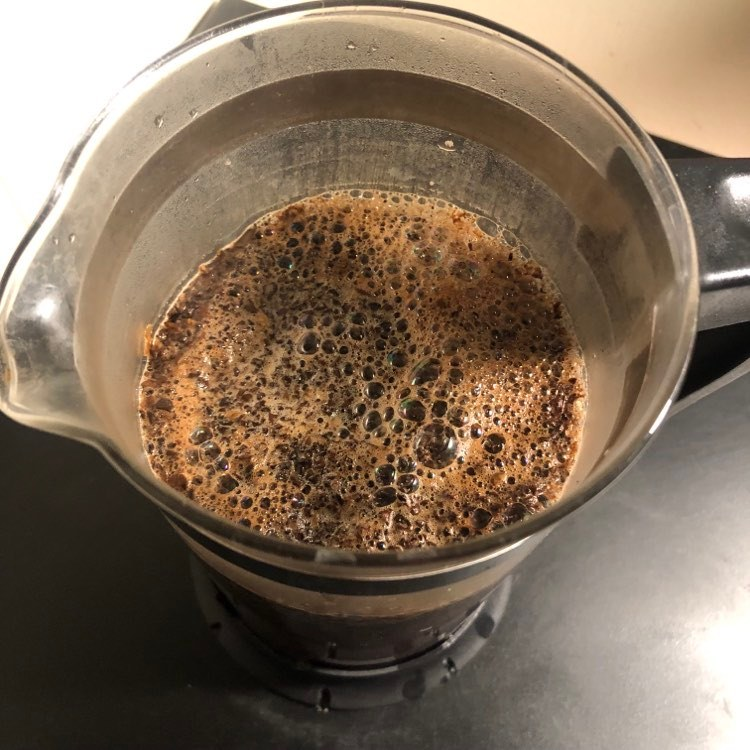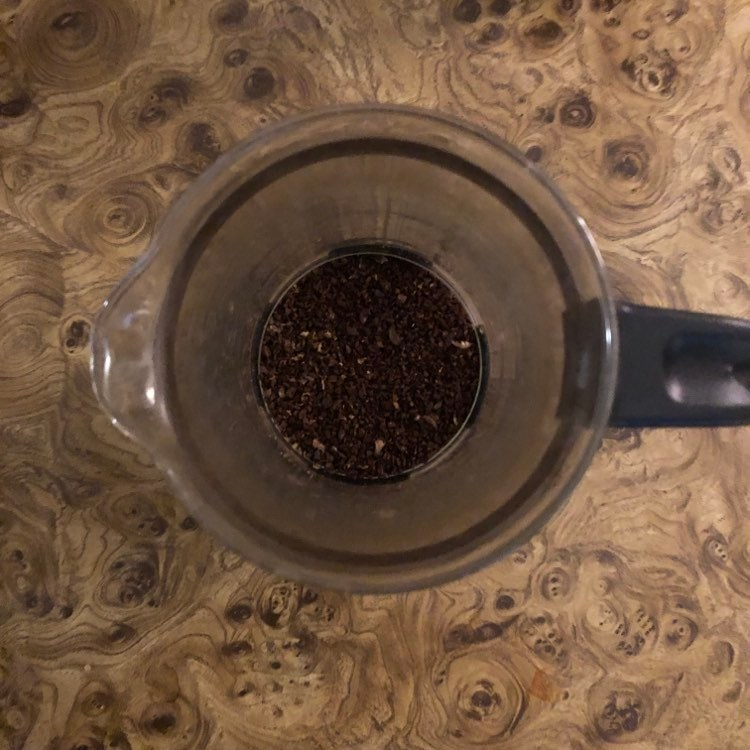I am a self-professed recovering coffee snob. While I appreciate a finely crafted cup of coffee, my opinions on it are much the same as my views on pizza: Even a mediocre pizza is still pizza, and thus is still pretty good pizza. It's a good cup of coffee if you like what's in your cup, and I hold that as truth.
However, on weekends I like to treat myself to a little meditation in a cup by making coffee with my French press. It's a process that I have practiced for years, and I have worked this practice to make an end product I thoroughly enjoy, so I'd like to share that with you.
First, I wake up earlier than I'd like. As I've gotten older (and no longer work until 11pm since I left the hotel industry), I've found my body likes to start the day before 6:30am, and generally likes to get going by 5:30am. So, silently, as to not wake up my spouse, I make my way to the kitchen and gather my tools for a good batch of coffee.
I like a good whole bean coffee when making coffee in a press.
Caster's Coffee is a local roaster in Lancaster, California, who trains and employs unhoused people in the community to help elevate them from homelessness. They roast beans from small, independent farms from Central America and Africa in their facility not too far from my house. I like their Poppy Blend; it's bright, mildly floral, and even-bodied, though their Challenger Blend dark roast is great too.
I have found that grinding beans by hand in a burr grinder produces better results than with an electric blade grinder; a burr grinder gives a more consistent grind than a blade grinder so there isn't so much sludge on the bottom of the cup, though a blade grinder is fine for drip coffee in my opinion. Grinding by hand is a slow process but one that allows me to appreciate the aroma of the coffee and the feel of the grounds, and grinding whole beans allows the oils inside them to be released as fresh as possible, making a more complex and delicious cup.
I measure out about three tablespoons of beans per cup-- not like per 8 fluid ounces, but for each cup of coffee I plan to drink, which is more like 12 ounces or so I think. Generally, with a drip machine, I'll do one tablespoon of ground coffee to 6 ounces of water, but I like a more robust batch of pressed coffee. Plus, I find a coarser grind can make a batch of coffee weaker, so I err on the bolder side.
I fill my kettle with two coffee cups of water, plus another third or so to compensate for the water absorbed by the grounds. The kettle itself is an Optimus Terra that I got from Elevation Sierra Adventure Essentials years ago after using it to transfer eggnog to my first world-renowned Independence Fruitcake Festival. Over the years-- and many cups of coffee and tea-- I've come to learn the sounds it makes when the water is the temperature I want. The recommended temperature to brew coffee is 200F, and most hot water dispensers and electric kettles will get to about that, but as long as the water is just below boiling you're good.

After my kettle gives a low pitched rumbling and wisps of steam start flitting out of its little spout, I slowly pour the water onto the grounds in the press in a circular motion, being mindful to not dump in all the water at once. A nice frothy bloom is produced, and even though some people think it's sacrilegious I like to stir the grounds and water to better incorporate the whole mix.
The press itself is one I found in Ikea some years ago, but before that I used a stainless steel one my brother found in the lost and found of the hotel we worked at back in 2009. The mesh strainer of the steel one was pretty ratty by the time I got the Swedish mass-market replacement, but it still worked fine, and I use the old metal press whenever I go camping. For home use-- and the sake of easier cleanup-- the little glass one with the melted base from that time I set it on a hot burner does the job quite well.

I let it sit and steep for about 15 to 20 minutes after pouring the water. Theoretically it's good to go after 7 to 10, but I like to give it an opportunity to rest and really let the water extract all the goodness it can. During that time I occasionally tidy up around the house, open up the doors and windows during the warmer months to let in fresh air, open the blinds and curtains during the cooler months to bring in sunshine, or take a quick shower to help start my day, but generally just appreciate the stillness of the early morning and the little sounds of life outside.
After that time has passed and the coffee has cooled to a drinkable temperature, I slowly depress the plunger of the press, and with that it's ready to serve. I slowly pour myself a cup to ensure as little mud as possible from the bottom of the press gets out, and with the first sip take time appreciate the warmth, aromas, and flavors I worked to produce.
I reserve this for my weekends because, admittedly, it's time consuming. During the week I program a drip machine with pre-ground coffee to have a pot ready as soon as I roll out of bed, and as a functional beverage it's a great thing. After all, I don't always have two hours to dedicate to making and drinking a couple cups of coffee, and a convenient way to access caffeine before a 6:30am work shift is a beautiful thing I wouldn't want to give up any time soon.
However, I think it's important to set a day aside, or at least a morning-- any time of day, really-- every now and again to dedicate to a methodical and meditative process. It's easy to feel detached from things, and making things by hand is a way to connect with those little joys we sometimes take for granted. Making a quilt and pouring love and attention to its construction helps you appreciate it even more when you're snuggled up on a cool evening. Building a birdhouse gives you a place for the wildlife to hang out and something nice to look at. Growing your own tomato gives a sense of pride along with a third of your BLT. Cooking a meal from scratch helps you appreciate the nourishment it provides, and allows you to practice making something you like if you're not so talented in the kitchen (like me). Brewing coffee in a slower, low-tech way helps you appreciate the stillness of the morning and the quality of a good cup of coffee.
Make something nice for yourself. You'll enjoy it.





